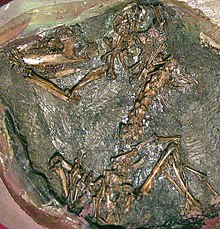Henkelotherium
| Henkelotherium Temporal range: Late Jurassic, | |
|---|---|
 | |
| Skeleton | |
| Scientific classification | |
| Domain: | Eukaryota |
| Kingdom: | Animalia |
| Phylum: | Chordata |
| Class: | Mammalia |
| Order: | †Dryolestida |
| Genus: | †Henkelotherium Krebs, 1991 |
| Species: | †H. guimarotae |
| Binomial name | |
| †Henkelotherium guimarotae Krebs, 1991 | |
Henkelotherium is an extinct genus of dryolestidan mammal from the Late Jurassic (Kimmeridgian) Camadas de Guimarota, in Portugal.[1] Unlike many other Jurassic mammals, it is known from a largely complete skeleton, and is thought to have had an arboreal lifestyle.
Description
[edit]The skull of Henkelotherium is 4 cm (1.6 in) long, and presacral body length is 11 cm (4.3 in). This suggest a weight of about 20 g (0.71 oz).[2]
Paleobiology
[edit]Primitive characters of Henkelotherium (e.g. asymmetric condyles of the femur) indicate that this species had a mode of locomotion similar to tree shrews and opossums. The small size of Henkelotherium and elongated tail made it suited to an arboreal lifestyle and capable of climbing trees, a notion supported by the paleoecological reconstruction of the Guimarota ecosystem indicating a densely vegetated environment.[3][4]
Taxonomy
[edit]In cladistic analyses, Henkelotherium has been considered closely related to Dryolestidae, either as a part of that group, or as closely related but placed outside that family as a non-dryolestid dryolestidan.[5]
See also
[edit]References
[edit]- ^ Krebs B., 1991. Das Skelett von Henkelotherium guimarotae gen. et sp. nov. (Eupantotheria, Mammalia) aus dem Oberen Jura von Portugal. Berl Geowiss Abh A.: 133:1–110.
- ^ T. S. Kemp (2005). The Origin and Evolution of Mammals. Oxford University Press, USA. p. 183. ISBN 9780198507611. Retrieved 22 September 2022.
- ^ Vázquez-Molinero, R., Martin, T., Fischer, M. S. and Frey, R. (2001), Comparative anatomical investigations of the postcranial skeleton of Henkelotherium guimarotae Krebs, 1991 (Eupantotheria, Mammalia) and their implications for its locomotion. Zool. Reihe, 77: 207–216. doi: 10.1002/mmnz.20010770206
- ^ Jäger, K. R. K.; Luo, Z.-X.; Martin, T. (2020-09-01). "Postcranial Skeleton of Henkelotherium guimarotae (Cladotheria, Mammalia) and Locomotor Adaptation". Journal of Mammalian Evolution. 27 (3): 349–372. doi:10.1007/s10914-018-09457-2. ISSN 1573-7055. S2CID 254689452.
- ^ Lasseron, Maxime; Martin, Thomas; Allain, Ronan; Haddoumi, Hamid; Jalil, Nour-Eddine; Zouhri, Samir; Gheerbrant, Emmanuel (2022-06-02). "An African Radiation of 'Dryolestoidea' (Donodontidae, Cladotheria) and its Significance for Mammalian Evolution". Journal of Mammalian Evolution. 29 (4): 733–761. doi:10.1007/s10914-022-09613-9. ISSN 1064-7554. S2CID 249324444.
Further reading
[edit]- Ramón Vázquez Molinero: Comparative anatomy of Henkelotherium guimarotae (Holotheria), a late Jurassic small mammal, and its relevance for the evolution of the mode of locomotion of modern mammals. Dissertation. Freie Universität Berlin, Fachbereich Geowissenschaften, 2003. Dissertation Online
http://www.diss.fu-berlin.de/diss/receive/FUDISS_thesis_000000001206


 French
French Deutsch
Deutsch



